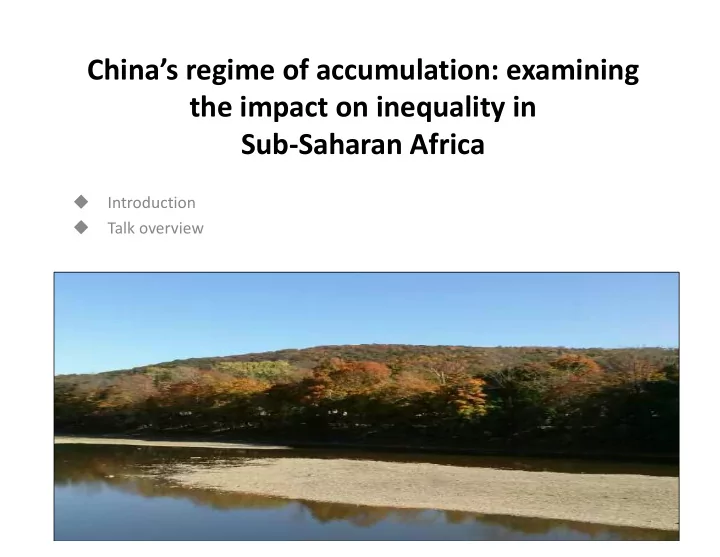

China’s regime of accumulation: examining the impact on inequality in Sub-Saharan Africa Introduction u Talk overview u
Systemic Cycles of Accumulation and Bifurcation u Marx’s general formula of capital as interpreted by Giovanni Arrighi, constitute an MC and CM’ phase M’ C M Phase A Phase B u The CM’ phase of US capital expansion, has been marked by a bifurcation between US military power and East Asian economic power
Long Centuries and Systemic Cycles of Accumulation [Arrighi 1994] Long 20 th century MC Long 18 th century CM’ MC Long 17 th century CM’ MC Long 15 th – 16 th century MC CM’ CM’ 1900 2000 1500 1600 1700 1800 1400
Inequality in the World-Economy u during times of organic crises, structural contradictions such as inequality reveal themselves u “growing financialization of processes of capital accumulation during each transition was associated with a rapid and extreme polarization of wealth”
Contemporary China-Africa Relations u a Progamme for China-Africa Cooperation in Economic and Social Development was approved and grounded on the principles of equality and mutual benefit, diversity, practical results, common progress, and amicable settlement of differences
Increasing Trade, FDI & Aid u China’s SSA imports increased from 3% in 2001 to 11% as of 2012 and SSA’s imports from China increased 15% to 20% (as opposed to decreasing imports from DAC members from 75% to 35%). u Trade relations between SSA and China is concentrated in Nigeria, South Africa, Liberia, Ghana, Benin, and Angola accounting for more than 80% of total imports from China. u the Chinese, “were well aware that resource scarcities, particularly in domestic energy, would soon become an issue for domestic production, and they moved to position the country to overcome that challenge” (Brautigam, 2008).
NIGERIA LIBERIA BENIN GHANA DEM. REP. CONGO EQ. GUINEA ANGOLA Africa to China Export Concentration * Angola * S. Africa * Dem. Rep. of Congo * Eq. Guinea S. AFRICA
Export Concentration from SSA to China [Sandrey 2006] 100% 100 50% 50 0 0 1995 2005 1995 2005 Oil Iron Ore Cotton Other
Export Concentration from SSA to China [IMF 2011] 100% 100 50% 50 0 0 1995 2011 1995 2011 Other Chemical Man. Crude Fuel Goods Materials
Economic impacts u From 1995 to 2013, the region has enjoyed an average GDP growth rate of 4.5% (compounded weighted average of “developing SSA” u Average un-weighted growth rates across all SSA countries for the period is 2.4% translating into an increase of about 30% GDP Per Person on average u for resource-rich SSA countries, one percentage point increase in China’s domestic investment growth is accompanied by a 0.8% increase in export growth rate.
China in Africa
Recommend
More recommend